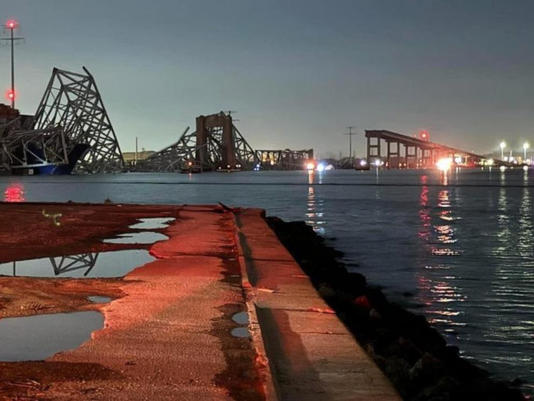In the heart of Baltimore, tragedy unfolded in the early hours of Tuesday morning as the Francis Scott Key Bridge, a vital artery of the city’s transportation network, was struck by a container ship, resulting in a partial collapse. The calamity sent shockwaves through the community, with vehicles and individuals plunged into the waters below. As emergency responders rushed to the scene, the full extent of the devastation became apparent, prompting an urgent search and rescue operation. In the wake of this harrowing event, questions abound regarding the causes, consequences, and future implications of the bridge collapse.
The Bridge Collapse: A Prelude to Chaos: At approximately 1:35 a.m., the tranquility of the night was shattered by reports of a partial bridge collapse at the Francis Scott Key Bridge. Initial accounts indicated that the collapse was triggered by a ship strike, as the container ship Dali, en route to Sri Lanka, collided with the structure. The impact of the collision reverberated across the city, leading to a cascade of events that would alter the lives of countless individuals. As vehicles teetered on the brink of oblivion and terrified commuters found themselves immersed in icy waters, the urgency of the situation became abundantly clear.
Search and Rescue Efforts: Race Against Time: Amidst the chaos and confusion, the heroic efforts of first responders and emergency personnel emerged as beacons of hope in the darkness. With unwavering resolve, divers plunged into the frigid waters of the Patapsco River, braving treacherous conditions to search for survivors. Throughout the night, the relentless pursuit of rescue operations persisted, driven by the imperative to save lives and reunite families torn asunder by tragedy. Yet, as the hours ticked by and the magnitude of the disaster became apparent, the race against time intensified, underscoring the critical need for swift and decisive action.
Assessing the Fallout: Impacts and Ramifications: As dawn broke over the ravaged landscape, the true extent of the damage wrought by the bridge collapse began to emerge. Beyond the physical destruction inflicted upon the infrastructure, the human toll of the disaster weighed heavily on the collective consciousness. Families anxiously awaited news of their loved ones, their hopes and fears intertwined in a tumultuous dance of uncertainty. Meanwhile, the economic repercussions of the incident reverberated throughout the city, disrupting transportation networks and impeding the flow of commerce. In the days and weeks ahead, the process of recovery and reconstruction would test the resilience of the community, demanding unity, perseverance, and unwavering resolve in the face of adversity.
Lessons Learned: Toward a Safer Future: As the dust settles and the healing process begins, it is incumbent upon us to reflect on the lessons gleaned from this tragic event. The Francis Scott Key Bridge collapse serves as a stark reminder of the fragility of our infrastructure and the imperative of proactive maintenance and oversight. Moreover, it underscores the need for enhanced safety protocols and contingency plans to mitigate the risks posed by maritime traffic in densely populated areas. Moving forward, a concerted effort must be made to prioritize infrastructure investment, bolster emergency preparedness, and foster a culture of vigilance and accountability.
The collapse of the Francis Scott Key Bridge stands as a somber testament to the unpredictable forces that shape our world. Yet, even in the darkest of hours, the indomitable spirit of humanity shines through, illuminating the path forward with hope and resilience. As we come together to mourn the lives lost and support those affected by this tragedy, let us reaffirm our commitment to building a safer, stronger future for generations to come.
